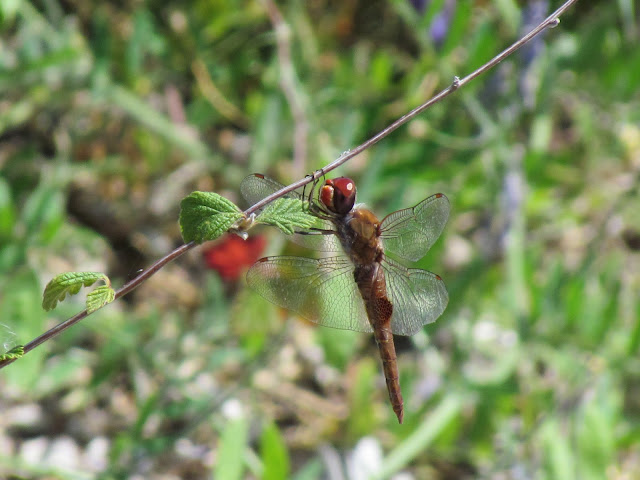We've only seen this dragonfly once or twice before, and those observations were in Arizona. Our first sighting was at the Gilbert Water Ranch in Gilbert, AZ. We saw an unusual dragonfly flying and flying, but with persistence we finally saw it land. It stayed put long enough for a few pictures for identification before it took off never to be seen again. We may have seen another in Cottonwood, AZ, but it never landed and didn't come close enough for a positive ID.
We were quite surprised, then, to see a Spot-winged Glider whizzing past us at Magnuson Park in Seattle, WA late in July. It had the look of a glider – similar to the more common Wandering Glider, but darker and more reddish – and as we watched it fly by a couple times we finally got a good look at its spots. Knowing this was an unusual sighting, we wanted to have photographic documentation, so we watched it carefully until it landed for us. Below are a few pictures I got that show it was a male Spot-winged Glider. The pictures aren't great, but they document this unusual sighting.
| The Spot-winged Glider finally landed for us, though in a fenced off area where we couldn't get very close. Notice the hamules on segment 2 of the abdomen, indicating that this individual is a male, and the dark spot on the hindwing. |
 |
| From some angles, the spots on the hindwings can be a bit hard to see since they are so close to the abdomen. |
 |
| A better look at the spots here. Notice also the great width of the hindwing, almost half the length of the abdomen. |
We were curious to see just how unusual it is to see a Spot-winged Glider in this part of the country. Checking with Dennis Paulson we discovered that he has seen the Spot-winged Glider in King County only once before – he saw a single individual fly by and disappear at Magnuson Park two years ago. We also checked with the new field guide Dragonflies and Damselflies of Oregon by Kerst and Gordon. They state the following:
We have one photographic record of this rare dragonfly from 2001, hanging up in a flower garden in the Friendly neighborhood in Eugene.
The only other reported sighting in Oregon was in Medford in 2009.
We're glad we were able to get photos of this individual, and that Dennis also saw and photographed it when he visited the park the next day. You just never know what you're going to encounter when you go out into the field.

































